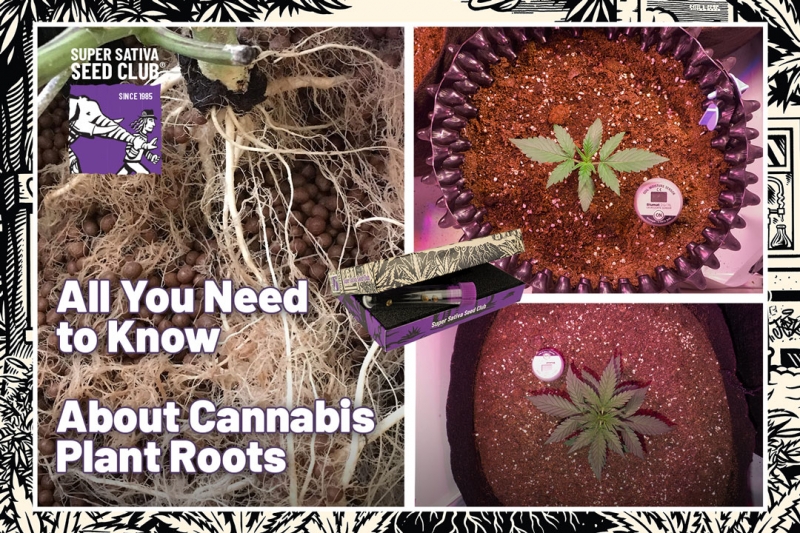
If you are growing from Cannabis seeds or clones, the early stages of root development are key for the plant's survival, as well as nutrient uptake and its ability to photosynthesis and convert sugars. Your goal as a grower should be to produce the biggest and most abundant root mass possible. In this article we explain about the importance of plant roots, the role of beneficial bacteria and fungi and cover 5 top tips to consider the next time you are growing from seed.
What are roots, and why are they important?
Root cells are the first part of a Cannabis seed to emerge. This small white tail is the beginning of what will soon become a prolific root mass full of hairs. The role of the roots is to search out air pockets for moisture, nutrients and beneficial bacteria and fungi. As a bi-product of photosynthesis, plants send glucose down the roots in an effort to attract helpful microorganisms, probiotic bacteria and mycorrhizal fungi.
The state of the roots of a Cannabis plant will determine how healthy the plant grows, the shape, structure, ability to convert and use nutrition, as well as yield potential. There are different types of roots ranging from the most common being the tap root, adventitious roots and fibrous roots.
Tap root - The main function of the tap root is to grow as deep as possible inside the growing medium, and to effectively anchor itself down. The deeper a tap root can penetrate, the more stable and strong the growth above the soil will be.
Fibrous roots - These will grow as thin white hairs with a fish bone structure. Responsible for searching out for nutrients and minerals in the surrounding growing medium.
Adventitious roots - These will usually grow above the soil and on the sides of the stalk. These types of roots will emerge from stem tissue.
Beneficial microorganisms and fungi
Did you know that in one small teaspoon of soil, there are millions of beneficial microorganisms? These will range from mycorrhizal fungi, actinomycetes, diazotrophic bacteria, probiotic bacteria and rhizobia. Helping to fight off pests and pathogens, the little helpers will provide the roots with a constant supply of nutrients.
● Root mass will be increased, resulting in faster nutrient uptake.
● Yields will be significantly bigger when using fungi and bacteria.
● The composting of organic material will be greatly accelerated.
● Harmful pathogens and plant disease are kept at bay.
● Cannabis plants can endure longer dry periods than normal.
● The growing medium can be reused with fungi and bacteria.
● Roots form symbiosis with the fungi, completing enhancing the soil food web.
So which pots will produce the best roots?
As a beginner grower, buying some cheap black plastic pots will most likely be your first ever venture. After a while, you may learn about other pots with air pruning capabilities designed to increase root mass.
Basic plastic pots
A cheap and cheerful option resulting in the roots of a plant becoming root bound. Plastic pots work well, but may not produce a root zone as impressive as one which has been air pruned.
Felt fabric pots
Felt allows air to pass through and when used for growing Cannabis plants in, fabric pots are brilliant. A popular choice amongst outdoor growers looking to grow massive plants, fabric pots will keep the roots in optimal shape and well insulated.
Air pots
You may have seen these shiny rubber looking pots full of holes in your local grow shop and thought how do these work? Air pots are an excellent way to encourage a prolific root mass, whilst root pruning at the same time.
5 Top Tips for growing the best roots
Top tip #1 - The right temperature
Cannabis plant roots love the growing medium to be warm, wet and airy. Cold pots will result in the soil being cold and restrict root development. Our top tip here is to use coco and soil for the best chance of root growth, and don’t let the grow room temperature drop below 18 degrees Celsius.
Top tip #2 - Root boosters
As an indoor grower, anything that can help take your root mass to another level is always an advantage, and using root boosters is one of them. Root boosters are nutrients specifically designed for early development of seedlings and clones. Our top tip here is to apply the root booster with every feed until the flowering period.
Top tip #3 - Provide carbon
One thing beneficial bacteria and fungi love is a rich source of carbon. Whilst they provide the plants with the primary and trace elements needed, in exchange they will want carbon. Our top tip here is to use compost or biochar as a hard food source, or to use a molasses based nutrient, fish emulsion, or seaweed as a liquid alternative. We love to use BIOtab’s Orgatex and strongly recommend this product as a source of carbon.
Top tip #4 - Root bound plants
This simply means when the pot has become too small for the root mass, causing the roots to grow downwards in a spiral motion. Our top tip here is to make sure that you repot the plants whenever the roots are filling over 75% of the pot and growing medium.
Top tip #5 - Beneficial bacteria and fungi
If you want the ultimate root mass that is working in harmony with millions of microscopic beneficial organisms, then you need to add bacteria and fungi. Our top tip here is to invest in BIOtab’s Mycotrex in conjunction with BIOtab’s Bactrex for the best root development and health possible.
Our conclusion
A healthy root zone will often be reflected by vibrant, vigorous looking plants capable of growing very fast. The more root mass you can produce prior to flowering will play a huge role in how productive the plants will become, as well as the final quality of the crop. Inoculating your growing medium with beneficial bacteria and fungi is one of the best ways to get a head start as a grower!
(1304) (0)

